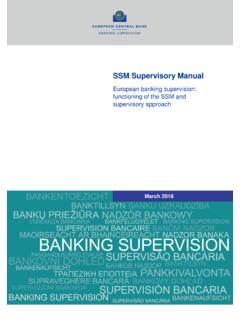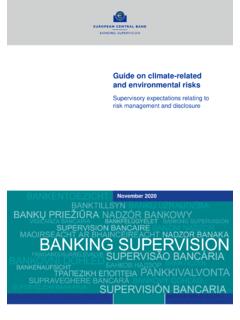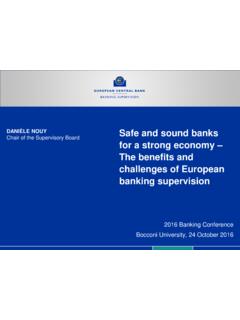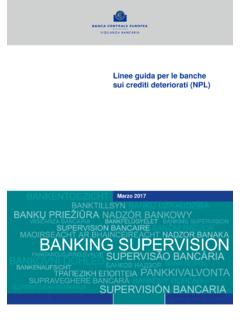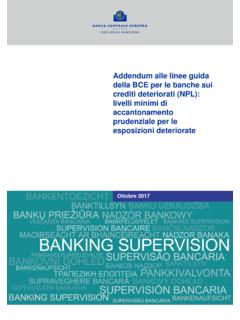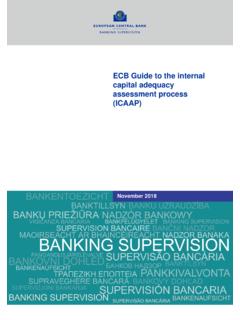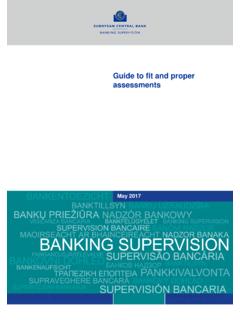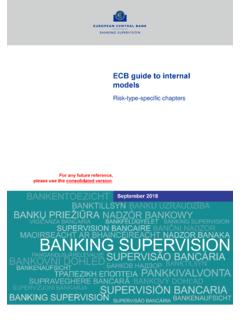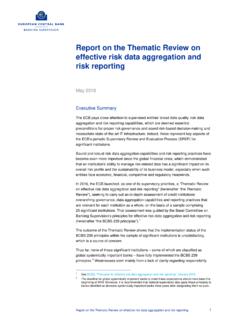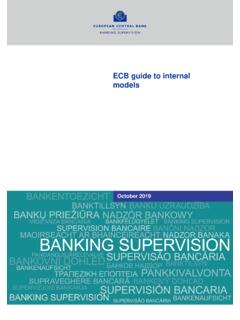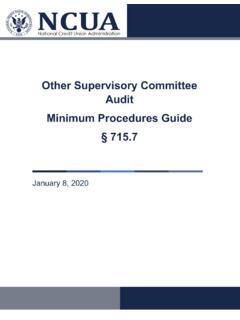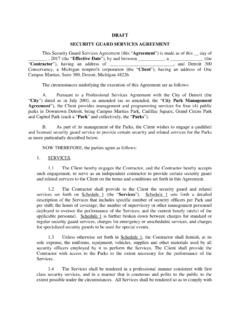Transcription of The state of climate and environmental risk management in ...
1 The state of climate and environmental risk management in the banking sector Report on the supervisory review of banks approaches to manage climate and environmental risks November 2021 The state of climate and environmental risk management in the banking sector Contents 1 Contents Executive summary 2 1 Introduction 6 management and supervision of climate -related and environmental risks 6 Organisation of the assessment 7 2 The state of climate -related and environmental risk management in the banking sector 10 Overview of institutions practices and plans 10 Main trends in current practices 11 Main trends in implementation plans 13 Institutions views on the materiality of risks 15 3 Business models 18 Observations from the assessment 18 Good practices 20 4 Governance and risk appetite 23 Observations from the assessment 23 Good practices 26 5 Risk management 33 Observations from the assessment 33 Good practices 38 6 Disclosures 45 Observations from the assessment 45 Good practices 46 7 Conclusions 48 The state of climate and environmental risk management in the banking sector Executive summary 2 Executive summary In the first ever exercise of its kind, the European Central Bank (ECB) comprehensively assessed the state of climate -related and environmental (C&E) risk management in the banking sector.
2 In its Guide on climate -related and environmental risks published in November 2020, the ECB set out 13 supervisory expectations for institutions with a view to addressing these risks, when formulating and implementing their business strategy and their governance and risk management frameworks, and to become more transparent by enhancing their C&E risk disclosures The ECB requested 112 significant institutions (hereinafter institutions ) to conduct a self-assessment of their current practices against the 13 supervisory expectations and to submit implementation plans detailing how and when they would bring their practices into line with the Guide. The ECB has assessed these practices and plans to monitor the progress made as well as to identify shortcomings on an institution-by-institution basis. None of the institutions are close to fully aligning their practices with the supervisory expectations. The supervisory assessment covered 112 Single supervisory Mechanism (SSM) institutions with combined total assets of 24 trillion.
3 Some of those institutions have already taken considerable steps towards adapting their practices to reflect C&E risks, but most are still in the early stages of development. Institutions are aware of this, as they themselves deem 90% of their reported practices to be only partially or not at all aligned with the ECB s supervisory expectations. They have been candid about their need to improve their management and disclosure of C&E risks. The ECB recognises that the challenges linked to the integration of C&E risks into strategies, governance and risk management arrangements are constantly evolving. Therefore, the ECB is committed to continuing its dialogue with the institutions so that they keep on strengthening their management of C&E risks. This report is a key supervisory effort to share observations and good practices that illustrate avenues for aligning institutions' practices with the supervisory expectations Virtually all institutions that performed a thorough materiality assessment expect C&E risks to have a material impact on their risk profile in the coming three to five years.
4 Roughly half of the institutions expect C&E risks to have a material impact in the short-to-medium term. They view credit risk, operational risk and business model risk as being most sensitive to C&E risk drivers. Notably, the institutions that did not identify as being materially exposed to C&E risks were those which either did not conduct a materiality assessment or performed one with significant shortcomings. While steps are being taken to adapt policies and procedures, few institutions have put in place C&E risk practices with a discernible impact on their strategy and risk profile. management bodies are for example increasingly taking formal responsibility for the management of C&E risks (Table 1). However, in most cases, institutions have not developed the relevant risk reports for their management bodies The state of climate and environmental risk management in the banking sector Executive summary 3 to enable them to exercise this responsibility comprehensively.
5 Few institutions have made any effort at all to take stock of the type of data they would need in order to identify and report internally on C&E risks. Similarly, more than half of institutions have described C&E risks in their risk inventory, but less than one-fifth have included dedicated key risk indicators on C&E risks in their risk appetite statement. Over half of institutions have no concrete actions planned to embed C&E risks in their business strategy. Conversely, some institutions have started measuring and monitoring the alignment of their portfolios, defining indicators and considering how to both align their financing with the Paris Agreement while avoiding an excessive build-up of transition risks. Table 1 Overview of institutions that have integrated C&E risks into selected practices Section Expectation (1) Selected practices (2) Level of integration (3) Business models The integration of C&E risks in the systematic monitoring of the business environment 39% The use of C&E-related scenario analysis for the purpose of strategy setting 11% The integration of C&E risks in business strategy by setting key performance indicators 25% Governance and risk appetite The integration of C&E risks in the roles and responsibilities of the management body 43% The integration of C&E risks into the risks reports to the management body 14% The integration of key risk indicator(s)
6 On C&E risks in the risk appetite statement 17% The development of an approach to identify C&E data needs and to overcome gaps 7% Risk management The integration of C&E risks in credit risk sector lending policies 46% The integration of C&E risks in credit risk classification procedures for debtors 28% The assessment of the impact of C&E risks on the continuity of its operations 50% 10. The integration of C&E risks into the transaction due diligence of the investment process 11% 11. The conduct of an (ad-hoc) C&E-related stress test or sensitivity analysis 23% Disclosures The specification of the means and frequency of disclosing C&E risks in disclosure policies 6% Source: supervisory assessment based on institutions responses to the request to perform a self-assessment and to develop implementation plans in the light of the ECB s Guide on climate -related and environmental risks. Notes: (1) This column refers to the expectations set out in the ECB Guide under which the practices fall.
7 (2) This overview of selected practices illustrates relevant trends across the sector. It should not be interpreted as suggesting a prioritisation from the supervisory point of view. (3) This is the percentage share of the 112 institutions that have integrated C&E risks into the corresponding practices. Most institutions have a blind spot for physical risks and other environmental risk drivers, such as biodiversity loss and pollution. While institutions materiality assessments demonstrate that both physical and transition risks are as often found to be material, their risk management practices for physical risks are less advanced than for transition risk. Institutions have generally started with collecting data and developing capabilities for transition risks. Similarly, only a handful of institutions have started taking into account other environmental risk drivers, such as biodiversity loss and pollution. For virtually all institutions, such other environmental risks are still a blind spot.
8 The state of climate and environmental risk management in the banking sector Executive summary 4 The ECB identified a set of good practices across different expectations that originated from institutions spanning a range of business models and sizes. The good practices range from strategy-setting procedures to specific qualitative and quantitative indicators in risk appetite statements, and from materiality assessments to credit risk management . Across the board, the good practices demonstrate the ability of institutions to develop relevant risk management capabilities for the sound, effective and comprehensive management of C&E risks. They also demonstrate the importance of taking a strategic approach, especially in areas where data and methodological gaps are perceived to hinder the full implementation of the expectations in the short term. A selection of such practices is described in this report for illustrative purposes.
9 Virtually all institutions developed implementation plans to further improve their practices, but the quality of those plans varies considerably. Institutions were requested to develop implementation plans to improve their practices. These plans should clearly outline a road map with verifiable milestones and describe a robust process for their implementation and monitoring. The ECB reviewed the quality of these plans and assessed in particular whether they address existing gaps in the institutions practices. The quality of the plans submitted varied considerably across the institutions (Figure 1). Some institutions provided short and unsubstantiated answers to the questionnaire, while others submitted large project documents detailing all the actions planned over time. Figure 1 The state of C&E risk management in the banking sector in terms of institutions alignment with expectations and the adequacy of their plans to advance practices (the y-axis describes the level of alignment of 112 institutions practices to the supervisory expectations set out in the ECB Guide; the x-axis describes the level of adequacy of 112 institutions implementation plans to address gaps in their practices) Source: supervisory assessment based on institutions responses to the request to perform a self-assessment and to develop implementation plans in the light of the ECB s Guide on climate -related and environmental risks.
10 Note: Weighted average scores are plotted for the 13 supervisory expectations. InadequateAdequateNot alignedAlignedPartially alignedMostly alignedSomewhat inadequateBroadly adequateAdequacy of plansAlignment of practices to expectations The state of climate and environmental risk management in the banking sector Executive summary 5 All in all, institutions have started paving the way, but the pace of progress remains slow in most cases. The expected completion timelines submitted to the ECB show that many institutions will not have practices in place that are aligned with the ECB supervisory expectations in the near future. More than half of the institutions will not have completed their plans by the end of 2022 with a subset of those, amounting to roughly one-fifth, not having any short-term deliverables in place. These institutions may not be able to soundly, effectively and comprehensively manage C&E risks that they are exposed to.
